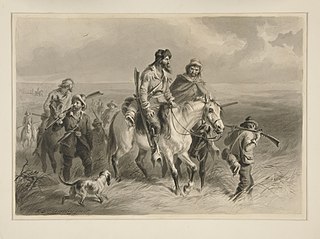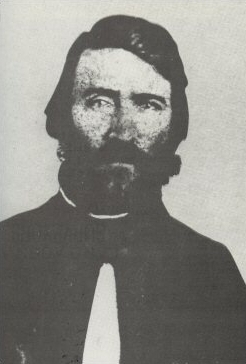Related Research Articles

The Compromise of 1850 was a package of five separate bills passed by the United States Congress in September 1850 that temporarily defused tensions between slave and free states in the years leading up to the American Civil War. Designed by Whig senator Henry Clay and Democratic senator Stephen A. Douglas, with the support of President Millard Fillmore, the compromise centered on how to handle slavery in recently acquired territories from the Mexican–American War (1846–48).

Historians who address the origins of the American Civil War agree that the preservation of the institution of slavery was the principal aim of the 11 Southern states that declared their secession from the United States and united to form the Confederate States of America. However, while historians in the 21st century agree on the centrality of the conflict over slavery—it was not just "a cause" of the war but "the cause" according to Civil War historian Chris Mackowski—they disagree sharply on which aspects of this conflict were most important, and on the North’s reasons for refusing to allow the Southern states to secede. Proponents of the pseudo-historical Lost Cause ideology have denied that slavery was the principal cause of the secession, a view that has been disproven by the overwhelming historical evidence against it, notably the seceding states' own secession documents.

In the context of the American Civil War (1861–65), the border states were slave states that did not secede from the Union. They were Delaware, Maryland, Kentucky, and Missouri, and after 1863, the new state of West Virginia. To their north they bordered free states of the Union, and all but Delaware bordered slave states of the Confederacy to their south.

Bleeding Kansas, Bloody Kansas, or the Border War was a series of violent civil confrontations in Kansas Territory, and to a lesser extent in western Missouri, between 1854 and 1859. It emerged from a political and ideological debate over the legality of slavery in the proposed state of Kansas.

The Territory of Kansas was an organized incorporated territory of the United States that existed from May 30, 1854, until January 29, 1861, when the eastern portion of the territory was admitted to the Union as the free state of Kansas.

In the United States before 1865, a slave state was a state in which slavery and the internal or domestic slave trade were legal, while a free state was one in which they were prohibited. Between 1812 and 1850, it was considered by the slave states to be politically imperative that the number of free states not exceed the number of slave states, so new states were admitted in slave–free pairs. There were, nonetheless, some slaves in most free states up to the 1840 census, and the Fugitive Slave Clause of the U.S. Constitution, as implemented by the Fugitive Slave Act of 1793 and the Fugitive Slave Act of 1850, provided that a slave did not become free by entering a free state and must be returned to his or her owner.

Border ruffians were proslavery raiders who crossed into the Kansas Territory from Missouri during the mid-19th century to help ensure the territory entered the United States as a slave state. Their activities formed a major part of a series of violent civil confrontations known as "Bleeding Kansas", which peaked from 1854 to 1858. Crimes committed by border ruffians included electoral fraud, intimidation, assault, property damage and murder; many border ruffians took pride in their reputation as criminals. After the outbreak of the American Civil War in 1861, many border ruffians fought on the side of the Confederate States of America as irregular bushwhackers.
The Wyandotte Constitution is the constitution of the U.S. state of Kansas.

The New England Emigrant Aid Company was a transportation company founded in Boston, Massachusetts by activist Eli Thayer in the wake of the Kansas–Nebraska Act, which allowed the population of Kansas Territory to choose whether slavery would be legal. The Company's ultimate purpose was to transport anti-slavery immigrants into the Kansas Territory. The Company believed that if enough anti-slavery immigrants settled en masse in the newly-opened territory, they would be able to shift the balance of political power in the territory, which in turn would lead to Kansas becoming a free state when it eventually joined the United States.

During the American Civil War, Missouri was a hotly contested border state populated by both Union and Confederate sympathizers. It sent armies, generals, and supplies to both sides, maintained dual governments, and endured a bloody neighbor-against-neighbor intrastate war within the larger national war.

At the outbreak of the American Civil War in April 1861, Kansas was the newest U.S. state, admitted just months earlier in January. The state had formally rejected slavery by popular vote and vowed to fight on the side of the Union, though ideological divisions with neighboring Missouri, a slave state, had led to violent conflict in previous years and persisted for the duration of the war.
Sylvanus B. Lowry was an American Democratic political boss, newspaper publisher and pioneer in St. Cloud, Minnesota before the American Civil War. He moved there from Kentucky, bringing slaves with him as laborers. He was a profiteer of slavery-related-enterprises. He was elected to the Territorial Council, as the first president of the town council, and to the Minnesota State Senate in 1862.
The timeline of Kansas details past events that happened in what is present day Kansas. Located on the eastern edge of the Great Plains, the U.S. state of Kansas was the home of sedentary agrarian and hunter-gatherer Native American societies, many of whom hunted American bison. The region first appears in western history in the 16th century at the time of the Spanish conquest of the Aztec Empire, when Spanish conquistadors explored the unknown land now known as Kansas. It was later explored by French fur trappers who traded with the Native Americans. It became part of the United States in the Louisiana Purchase of 1803. In the 19th century, the first American explorers designated the area as the "Great American Desert."

James Montgomery was a Jayhawker during the Bleeding Kansas era and a controversial Union colonel during the American Civil War. Montgomery was a staunch supporter of abolitionist principles and individual liberty. He liberated slaves during his raids. He also burned and looted pro-slavery populations.

The history of slavery in Missouri began in 1720, predating statehood, with the large-scale slavery in the region, when French merchant Philippe François Renault brought about 500 slaves of African descent from Saint-Domingue up the Mississippi River to work in lead mines in what is now southeastern Missouri and southern Illinois. These were the first enslaved Africans brought in masses to the middle Mississippi River Valley. Prior to Renault's enterprise, slavery in Missouri under French colonial rule had a much smaller scale compared to elsewhere in the French colonies. Immediately prior to the American Civil War, there were about 100,000 enslaved people in Missouri, about half of whom lived in the 18 western counties near the Kansas border.

Charles Rainsford Jennison also known as "Doc" Jennison was a member of the anti-slavery faction during Bleeding Kansas, a famous Jayhawker, and a member of the Kansas State Senate in the 1870s. He later served as a Union colonel and as a leader of Jayhawker militias during the American Civil War.

Kansas and Missouri are two bordering U.S. states with a long and tumultuous history. The relationship between these two states has its roots in Bleeding Kansas, but mutual distrust has continued off and on since then, even in sporting contexts. These states also share the Kansas City metropolitan area, where both states each have a city named "Kansas City" on either side of the Missouri River.

Jonathan H. Earle is an author, historian, professor, and dean. He is an historian of American politics and culture who focuses on the early republic and antebellum periods, especially the antislavery movement and the sectional crisis leading up to the Civil War. Currently Earle serves as Dean of the Roger Hadfield Ogden Honors College at Louisiana State University, a post he has held since 2014.

Samuel Jefferson Jones was a pro-slavery settler who held the position of Douglas County sheriff in Kansas Territory from late 1855 until early 1857. He helped found the territorial capital of Lecompton and played a prominent role in the "Bleeding Kansas" conflict.
References
- ↑ Cory, Charles Easterbrook. "Slavery in Kansas." Kansas Historical Collection 7 (1901-1902): 229-242.
- ↑ Kansapedia: Slavery in Kansas Territory, Kansas Historical Society
- ↑ Immigration and Early Settlement: Slaves in Kansas Territory, Territorial Kansas, Kansas Historical Society
- ↑ Mutti Burke, Diane. Slavery on the Western Border: Missouri’s Slave System and its Collapse during the Civil War, Civil War on the Western Border: The Missouri-Kansas Conflict, 1854-1865.